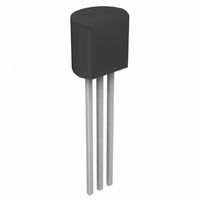LT1123CZ#TR Linear Technology, LT1123CZ#TR Datasheet - Page 10

LT1123CZ#TR
Manufacturer Part Number
LT1123CZ#TR
Description
IC LDO REG DRIVER 5V TO-92-3
Manufacturer
Linear Technology
Type
Positive Fixedr
Datasheet
1.LT1123CZ.pdf
(16 pages)
Specifications of LT1123CZ#TR
Number Of Outputs
1
Voltage - Output
5V
Current - Supply
700µA
Operating Temperature
0°C ~ 125°C
Package / Case
TO-92-3 (Standard Body), TO-226
Lead Free Status / RoHS Status
Contains lead / RoHS non-compliant
Voltage - Input
-
Available stocks
Company
Part Number
Manufacturer
Quantity
Price
APPLICATIO S I FOR ATIO
LT1123
PNP. If the output of the regulator circuit can be shorted,
heat sinking must be adequate to limit the rate of tempera-
ture rise of the power device to approximately 50°C/
minute. This can be accomplished with a fairly small heat
sink, on the order of 3 to 4 square inches of surface area.
Design Example
Given the following operating requirements:
1. The first step is to determine the required drive current.
2. The next step is to determine the value of R
3. We can now look at the thermal requirements of the
Worst-case power in the LT1123 will be equal to:
Given: V
Then: P
10
5.5V < V
I
Max ambient temperature = 70°C
V
This can be found from the Maximum Dropout Voltage
curve. 50mA of drive current will guarantee 0.4V drop-
out at an output current of 2A. This satisfies our
requirements.
50mA of drive current and a minimum input voltage of
5.5V, we can select R
the graph the value of R
use the next lowest 5% value which is 47Ω.
circuit.
(
OUTMAX
OUT
V
I
R
IN(MAX)
DRIVE
D
= 5V
= 47Ω
IN(MAX)
MAX
4R
IN
= 1.5A
= 50mA
D
– V
< 7V
(LT1123) = 0.22W.
BE
= 7V, V
)
U
2
D
BE
from the graph of Figure 4. From
U
D
= 0.6V, R
is equal to 50Ω, so we should
W
D
= 47Ω
D
U
. Based on
Assuming a thermal resistance of 150°C/W, the maximum
junction temperature rise above ambient will be equal to
(P
tion temperature will be equal to the maximum ambient
temperature plus the junction temperature rise above
ambient. In this case we have (maximum ambient = 70°C)
plus (junction temperature rise = 33°C) is equal to 103°C.
This is well below the maximum operating junction tem-
perature of 125°C for the LT1123.
The power rating for R
Figure 8 using V
should be sized to dissipate a minimum of 1/2W.
The worst-case power dissipation, for normal operation,
in the MJE1123 will be equal to:
The maximum operating junction temperature of the
MJE1123 is 150°C. The difference between the maximum
operating junction temperature of 150°C and the maxi-
mum ambient temperature of 70°C is 80°C. The device
must be mounted to a heat sink which is sized such that the
thermal resistance from the junction of the MJE1123 to
ambient is less than 80°C/3W = 26.7°C/W.
It is recommended that the LT1123 be thermally coupled
to the MJE1123 so that the thermal limit circuit of the
LT1123 can protect both devices. In this case the ambient
temperature for the LT1123 will be equal to the tempera-
ture of the heat sink. The heat sink temperature, under
normal operating conditions, will have to be limited such
that the maximum operating junction temperature of the
LT1123 is not exceeded.
Refer to Linear Technology’s list of Suggested Manufac-
turers of Specialized Components for information on
where to find the required heat sinks, resistors and capaci-
tors. This listing is available through Linear Technology’s
marketing department.
MAX
(V
INMAX
)(150°C/W) = 33°C. The maximum operating junc-
– V
OUT
IN
)(I
= 7V and R
OUTMAX
D
can be found from the plot of
) = (7V – 5V)(1.5A) = 3W
D
= 47Ω. From the plot, R
1123fb
D















